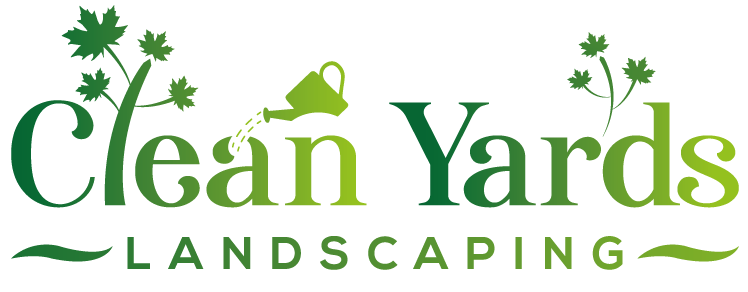Solve Kenmore Drainage: Fall Grading Before Winter Hits
Quick Takeaways:
- Fall grading corrects lawn slope to direct water away from foundations before winter freezes.
- Poor drainage leads to icy patches, foundation pressure, soggy lawns, and plant damage.
- Look for puddles, soggy spots, struggling grass, and water near foundations as warning signs.
- Grading involves adjusting soil levels, creating swales, or installing drains.
- Protect newly graded areas with dormant seeding and mulch before winter.
- Fall is the ideal time for grading due to workable soil and cooler temperatures.
Experiencing drainage issues or planning ahead? Don't wait for winter damage. Request your free quote for professional grading today!
Introduction: Hey Kenmore! Is Your Yard Ready to Weather an Ottawa Winter?
Well hello there, Kenmore neighbours! Fall is definitely in the air – cue the cozy sweaters and pumpkin spice everything, right? But as we gear up for another beautiful autumn, it's also prime time to think about preparing our yards for that *other* famous Ottawa season… winter! We all know it’s coming, bringing snow, ice, and the dreaded freeze-thaw cycle.
Before the ground freezes harder than a week-old bagel, let's talk drainage. Have you noticed any soggy spots or pooling water in your yard after a good rain? Maybe near the downspouts or in that low corner? Our friends over in Greely and Metcalfe see it too! Those seemingly small water issues now can become major headaches come winter – think treacherous ice patches on walkways or even water creeping towards your foundation. Yikes!
The good news? There’s a smart landscaping solution: fall grading. It’s all about gently reshaping the slope of your lawn before winter sets in. Proper grading guides melting snow and rain away from your house, preventing puddles and potential damage. Consider it essential lawn care and proactive gardening prep for a worry-free winter and a healthier yard next spring!
Why Fall Grading is Your Property's Best Friend Before an Ottawa Winter
Okay, let's chat about why giving your yard a little slope adjustment in the fall – what we landscapers call grading – is one of the smartest moves you can make before Old Man Winter settles into Ottawa. Think of it as giving your property a sturdy raincoat and boots before the slushy season!
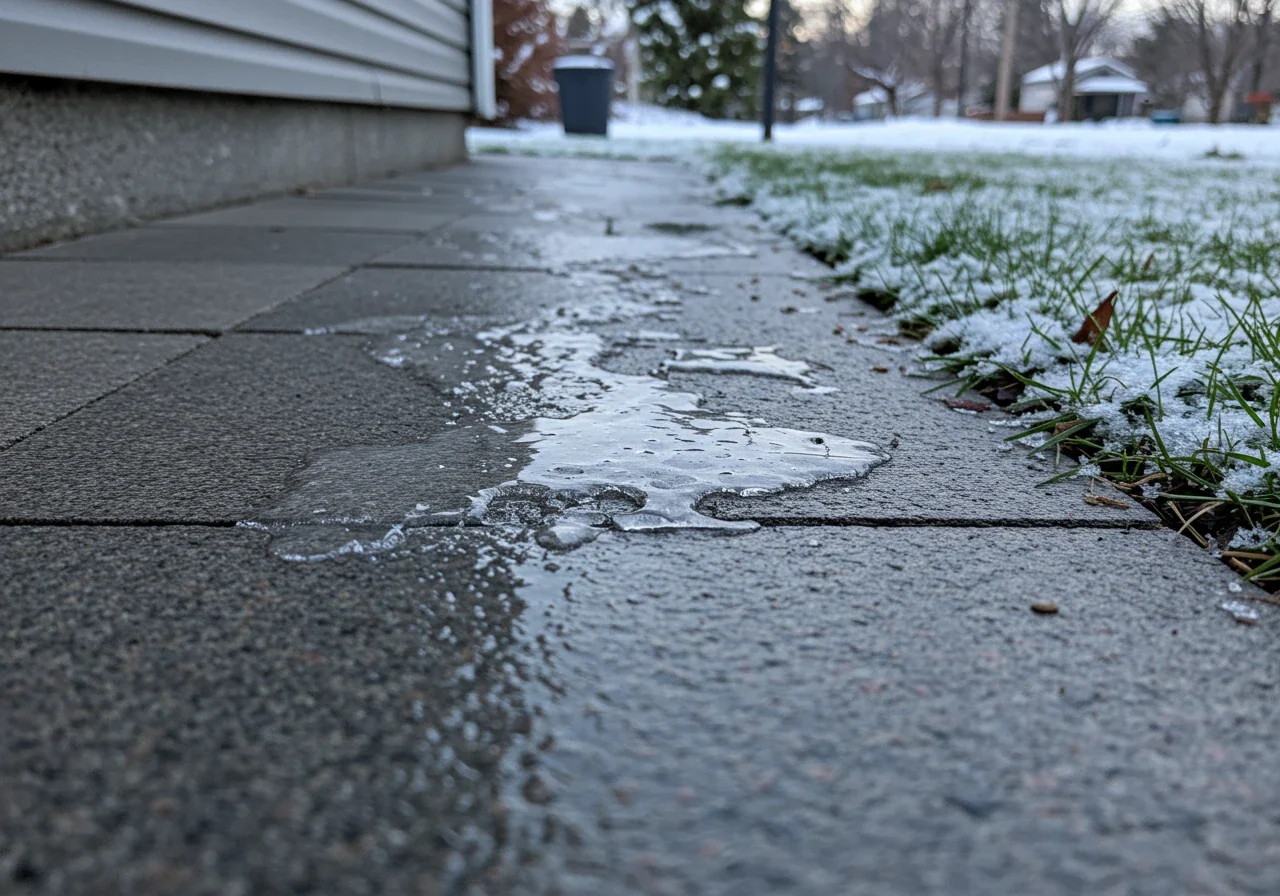
So, why the big fuss about fall grading? Well, Ottawa winters aren't exactly gentle giants, are they? We get that lovely freeze-thaw-freeze cycle happening. Water pools in low spots during a thaw, then bam, it freezes solid overnight. Suddenly, that harmless puddle near your walkway becomes a mini skating rink – not fun! Worse yet, water pooling near your house foundation can freeze and expand, putting pressure on the concrete. Over time, this can lead to cracks and potentially leaky basements. Nobody wants that expensive surprise come spring! Proper grading gently encourages melting snow and winter rain to flow away from your home, preventing these icy hazards and foundation stress. For a deeper dive, check out this helpful guide on understanding proper drainage and site grading.
Fall is the perfect time for this task. The ground is usually still workable, unlike the frozen tundra it becomes later, or the muddy mess it can be in early spring. Grading now gives the soil time to settle before the deep freeze. If you're adding topsoil or seeding the graded area, the cooler, moist fall weather is much kinder for establishing roots than the summer heat. Plus, addressing drainage issues now means less soggy lawn damage come springtime thaw. We know some areas around Ottawa, like near Osgoode or Russell, can deal with heavier clay soil, which makes good drainage even more critical. If that sounds familiar, you might find some useful info on tackling tricky clay soil drainage issues helpful. Reputable resources like the Rideau Valley Conservation Authority also offer insights into local water management.
Fixing poor drainage isn't just about preventing ice slicks; it's crucial for your lawn and garden health too. Constantly soggy soil suffocates grass roots and can lead to patchy, unhappy turf. It also impacts your garden beds – you’d be surprised how these damp spots affect your garden's microclimate, potentially creating overly cold, wet pockets where plants struggle. Think of proper grading as part of comprehensive fall garden care, setting the stage for a healthier landscape next year.
Getting your yard's slope right before winter is a proactive step that saves headaches and potential repair costs down the road. If reshaping your lawn sounds like a bit much, don't worry! Professionals can assess your property's needs and handle the grading efficiently. You can explore our landscaping services to see how we can help, and even combine grading with our fall garden clean up services for a complete pre-winter prep!
Drainage Dilemmas: Spotting the Warning Signs on Your Kenmore Property
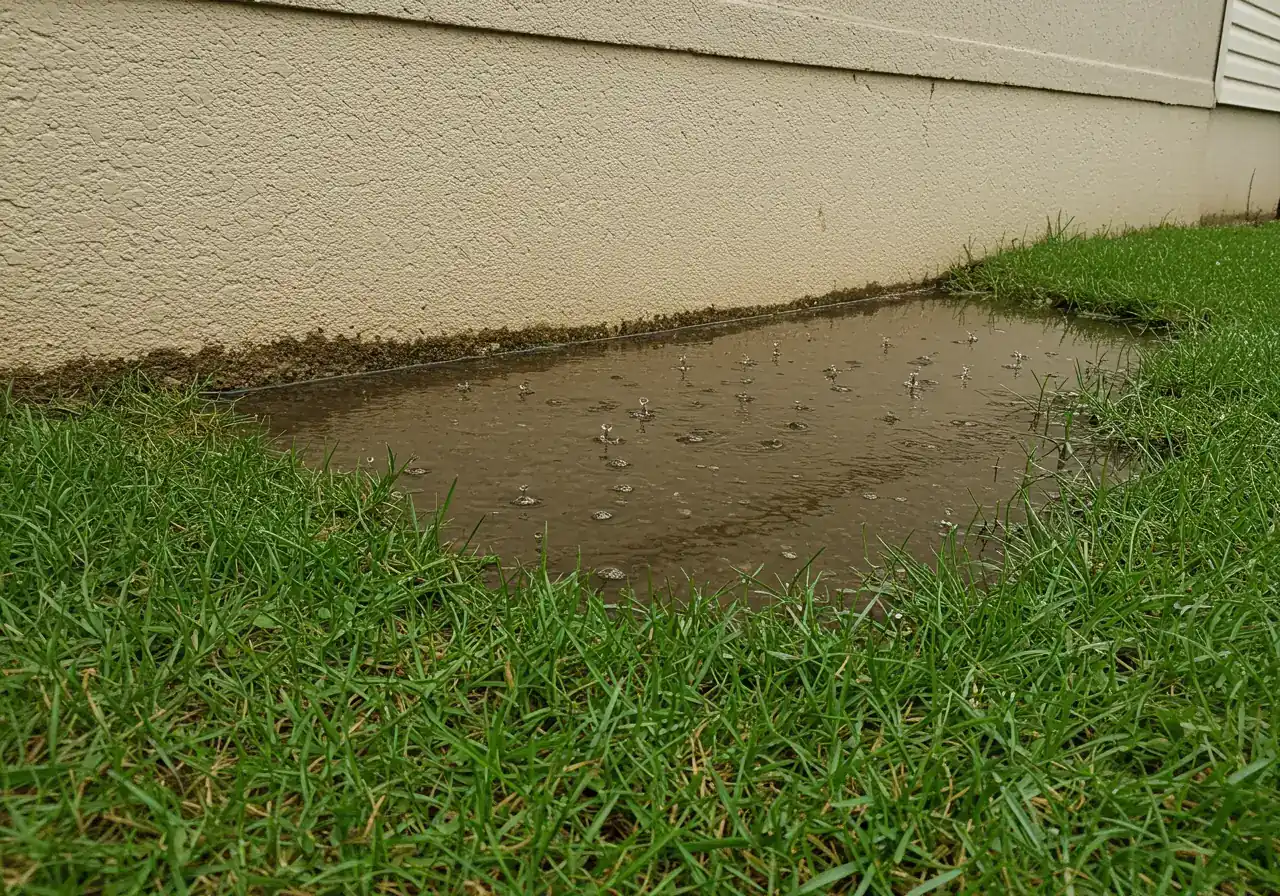
Alright, let's talk about something slightly less glamorous than blooming flowers but oh-so-important for your Kenmore property: drainage! Sometimes, water issues are sneaky, creeping up like that extra serving of dessert you thought no one saw you take. Ignoring them, however, can lead to soggy lawns, unhappy plants, and even foundation troubles down the road – problems folks across Ottawa, from Nepean to Barrhaven, sometimes face. But don't worry, spotting the signs early is half the battle!
So, what clues suggest your yard might be holding onto water a bit too affectionately?
- Persistent Puddles: If you have mini-lakes hanging around your lawn or patio more than a day after the rain stops, that’s a classic red flag. Water should ideally soak in or flow away within 24-48 hours.
- Soggy Spots & Squishy Lawn: Does stepping on certain parts of your lawn feel like walking on a sponge, even days after rain? That indicates poor soil drainage in those areas.
- Bare Patches or Struggling Grass: Constantly wet soil suffocates grass roots. If you have patches where grass just won't thrive, poor drainage could be the culprit.
- Moss & Algae: While a little moss can look quaint in the right setting, widespread moss or green algae on soil, patios, or walkways often signals consistently damp conditions.
- Overflowing Gutters & Downspout Dramas: Check your gutters during rain. If they're overflowing, or if your downspouts dump water right beside your foundation creating eroded patches, that's concentrated trouble waiting to happen. This can undermine even careful work like expert mulching and edging.
- Foundation Funnies: Look for water stains, damp patches, or white, chalky mineral deposits (efflorescence) on your foundation walls, inside or out.
Your Quick Drainage Detective Checklist:
Want to play detective on your own property? It's easy!
- Walkabout After Rain: Best time! Grab your boots and take a stroll. Note where water collects and how long it stays.
- Downspout Discharge Check: See where the water from your roof actually goes. Is it directed well away from the house?
- Low Spot Scan: Eyeball your lawn and garden beds. Are there obvious dips where water naturally wants to pool? Addressing these is vital before considering a new garden installation.
- Foundation Inspection: Peek at the base of your house, especially near downspouts or low spots.
- Clear the Clutter: Sometimes, drainage is simply blocked. Ensuring drains and ditches are clear is a key part of any thorough general property clean up. Think of it like our detailed Ottawa property cleanup service – getting rid of debris lets everything function better.
Catching these signs early is crucial. If you do spot potential issues, understanding the scope of any potential fix is important – always ensure you know what services entail, similar to how our terms and conditions outline our commitments. Addressing drainage problems proactively will definitely have you sending a big thank you to your past self when your yard emerges healthy and dry next spring!
Common Drainage Problems
Typical signs include standing water after rain, consistently wet or spongy lawn areas, moss growth, water stains on foundations, and gutters overflowing or dumping water too close to the house.
Check areas near downspouts and low points in your yard first.
Why Address Drainage Issues?
Ignoring poor drainage can lead to:
- Icy hazards on walkways and driveways in winter.
- Foundation damage from freeze-thaw pressure.
- Water seepage into basements.
- Unhealthy lawns and gardens due to waterlogged roots.
- Mosquito breeding grounds in standing water.
Check out our gallery for examples of drainage solutions.
Professional Drainage Solutions
Depending on the severity, professionals might recommend:
- Regrading the landscape for proper slope.
- Installing French drains or catch basins.
- Creating grassy swales to channel water.
- Extending downspouts effectively.
- Improving soil composition. (Learn about soil prep)
Need help? Contact us for an assessment.
Grading 101: Shaping Up Your Landscape for Better Drainage
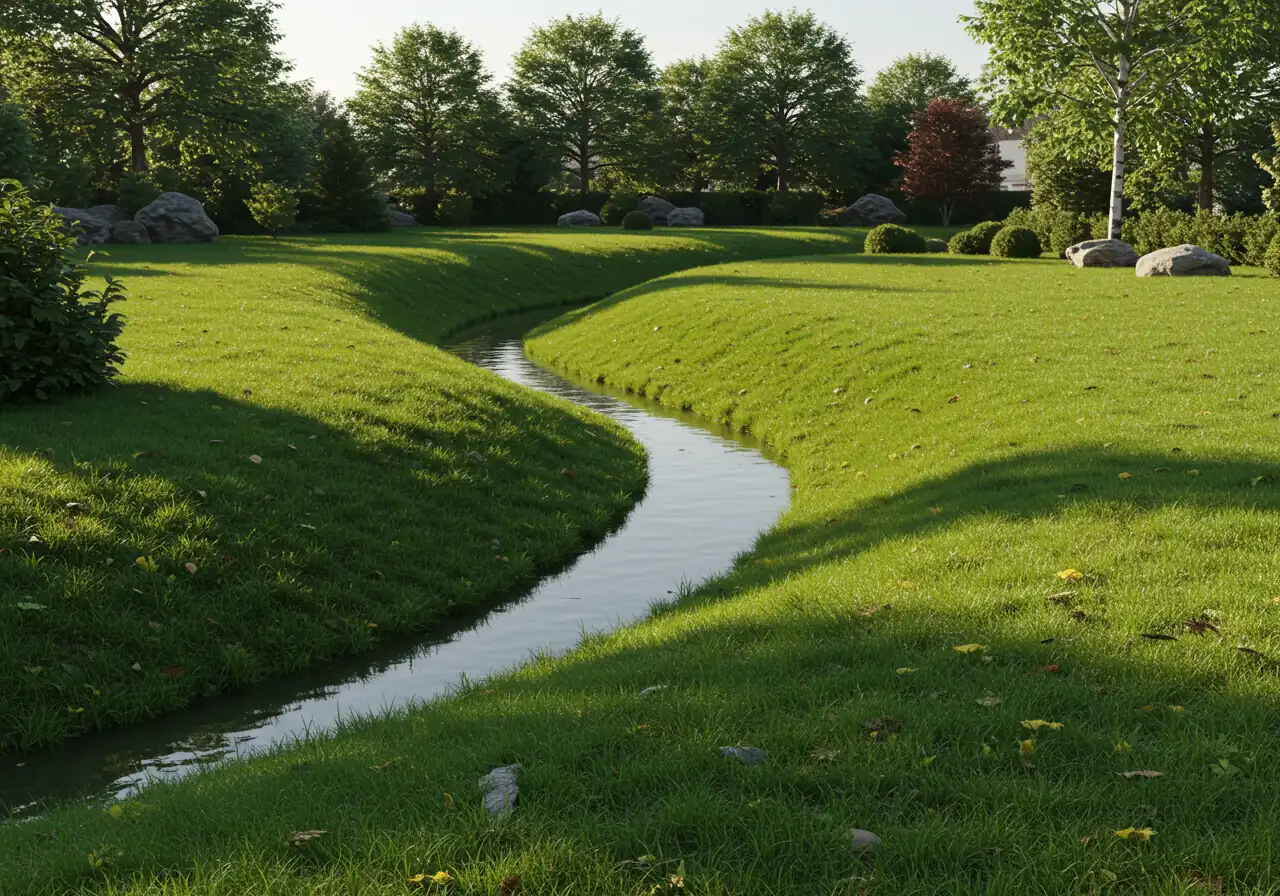
Alright, let's dive into the nitty-gritty of grading. It sounds technical, maybe even a little intimidating, but think of it like gently sculpting your yard so water knows exactly where to go – preferably away from your house! It’s a fundamental part of smart landscaping and lawn care here in Ottawa.
The star of the show is slope. This is just the fancy term for the slant of your land. For good drainage around your foundation, you want a gentle slope – think a drop of about 1/4 inch for every foot you move away from the house (that's roughly a 2% grade). It doesn't need to look like a ski hill, just enough tilt to convince water to mosey on elsewhere.
Now, what if you need to guide water across your yard, maybe around a patio or away from a low spot? Enter the swale. It’s essentially a shallow, wide ditch, often covered in grass or decorative rocks, that acts like a natural channel to direct surface runoff politely. For tougher, soggier situations, especially where water seems to bubble up from below, a French drain might be the answer. Despite the name, it’s not particularly French! It’s a trench lined with fabric, filled with gravel, and containing a perforated pipe that collects groundwater and carries it away.
So, how do we actually fix drainage issues using grading?
- Regrading: This often involves bringing in new soil or topsoil to build up low areas or carefully removing soil to create that crucial slope away from your foundation. It's the most direct way to reshape the land.
- Creating Swales: We can strategically design swales to intercept water and guide it to a street drain, a ditch, or perhaps a designated gardening area designed to handle moisture.
- Installing French Drains: For persistent groundwater problems, installing a French drain system redirects that subsurface water effectively.
- Eco-Friendly Options: Especially relevant in areas like Kars or Manotick near the water table, consider a rain garden. This is a beautifully planted depression designed to collect runoff, filter it naturally, and let it soak slowly into the ground. It can be a stunning feature, perhaps as part of a new garden installation. You can find resources on rain gardens from groups like Ottawa Field-Naturalists' Club for native plant ideas.
DIY vs. Hiring Pros: Making the Call
| Approach | Pros | Cons |
|---|---|---|
| DIY Grading | Can save money on labour for *very* small, simple jobs (e.g., extending downspout, filling tiny low spot). | Requires research, physical labour, potentially equipment rental. Easy to get slope wrong, potentially worsening the issue. Major grading is significant effort. |
| Professional Grading | Expertise for accurate assessment & solution design. Proper equipment for efficiency. Ensures correct slope & integration. Saves time & effort. Handles complex jobs (French drains, large regrading). See our team on the About Us page. Often follows prep like Ottawa property cleanup or Metcalf property cleanup. Can include lawn restoration (sod installation). Manage details via customer portal. | Involves project costs. |
Getting the grade right protects your home, keeps your lawn healthy, and prevents those annoying squishy spots. It’s an investment that pays off, especially before another Ottawa winter arrives! Find us on Google to see reviews.
The Fall Grading Playbook: A Step-by-Step Guide for Ottawa Homeowners
Alright, Ottawa homeowners, ready to tackle that fall grading project? Think of it as setting your yard up for a stress-free winter hibernation. Getting the slope right means saying goodbye to unwanted puddles and potential ice rinks! Here’s a step-by-step playbook to guide you through the process before the ground freezes solid.
Step 1: The Grand Assessment
After rain (or using a hose), identify pooling areas, especially near foundations. Check the slope. Use stakes/string if needed. Unsure? Book a free landscaping estimate.
Step 2: Plan Water Escape & Check Rules
Plan where water should flow (street, ditch, rain garden) - avoid neighbours' yards! Check City of Ottawa permit rules for major work. Your data is safe, see our privacy policy.
Step 3: Prep the Playing Field
Clear the area: furniture, decor, debris. Rake leaves. Locate utilities before digging! Combine with Ottawa or Metcalf garden clean up services.
Step 4: Let the Grading Begin!
Use existing soil for minor tweaks. Add topsoil for bigger slopes/fills. Spread evenly, compact gently, ensure slope away from buildings. Smooth transitions.
Step 5: Tuck It In for Winter
Protect bare soil! Use dormant seeding (suitable grass seed) and cover with straw mulch or landscape fabric. Essential for erosion control & future lawn care.
Step 6: Keep an Eye On It
After the next rain, observe water flow. Make minor adjustments if needed. Track progress with pros via the customer portal.
Timing is key! Aim to get your grading done before the first hard frost typically hits Ottawa, usually around late October or early November. This gives the soil a little time to settle and your protective layer to set before winter truly arrives. Following these steps will help ensure your yard handles winter moisture like a champ!
Pro Tip Highlight Box: Quick Wins for Kenmore Drainage
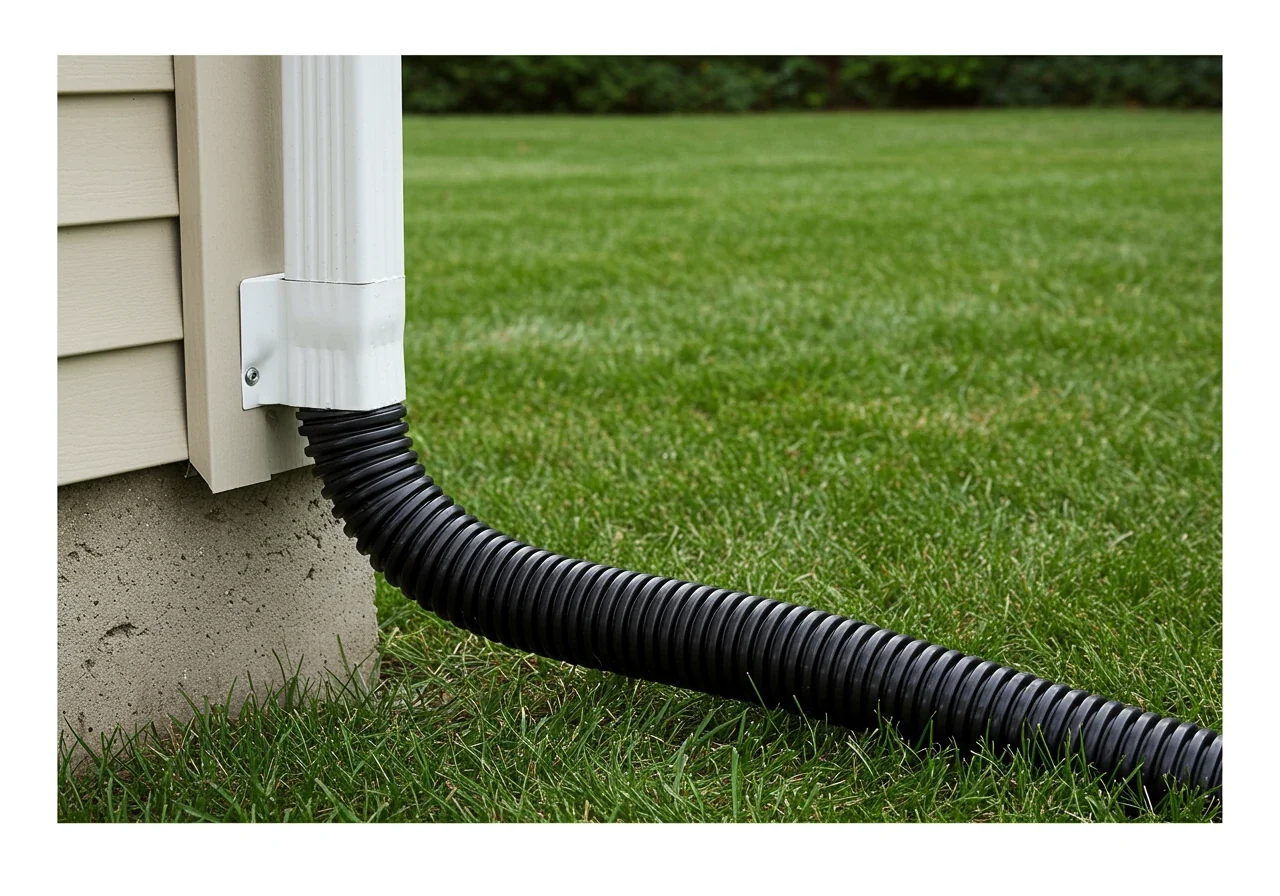
- Downspout Detective: Your quickest win! Ensure downspouts extend at least 4-6 feet away from your foundation. A simple extension from the hardware store can solve surprisingly big water pooling problems right next to the house. Easy peasy!
- Clear the Clutter: Pesky puddles often form because water has nowhere to go. Blocked gutters, window well drains, or ditches near your property are common culprits. Make checking and clearing these pathways part of your regular garden maintenance routine, especially in the fall.
- Fill Minor Dips: Got a small, annoying low spot in the lawn that turns into a mini-pond after rain? Sometimes, simply adding a bit of quality topsoil to raise the area and gently sloping it towards a better drainage path is all you need.
- Think Like Water (or a Raindrop): After the next decent rainfall, grab your boots and umbrella and take a walk. Where does the water actually go? Does it flow politely away from your house? Seeing the flow paths tells you exactly where potential grading or adjustments are needed. Need ideas? You can get inspired by our project gallery to see how different drainage solutions look on real properties.
- Combine & Conquer: If you're planning some fall landscaping or grading work, think about efficiency. It often makes sense to tackle multiple jobs at once. For instance, you might combine grading with services like our Marionville property cleanup to get your entire yard prepped for winter in one go. Also consider our Ottawa yard cleanup or Marionville yard cleanup options. We cover Metcalf too!
- Protect Bare Soil: Don't leave freshly graded soil exposed to Ottawa's fall rains and winter thaws! Cover it promptly with dormant grass seed and a layer of straw mulch, or use landscape fabric. This prevents your hard work (and precious soil) from washing away.
- When in Doubt, Ask! Feeling a bit overwhelmed by swales, slopes, or seriously soggy spots? Don't just start digging and hope for the best – you could accidentally make things worse. It's always smart to contact us with your drainage questions for professional advice before tackling complex issues.
- Aim for Satisfaction: Whether you DIY a small fix or hire pros for a bigger job, the ultimate goal is a yard that handles water properly. After the work is done and tested by a good rain, make sure you're happy with the results. We always appreciate hearing how things turned out, much like the valuable estimate feedback we use to continually improve our services.
Drainage Improvement Impact (Example Visualization)
Proper grading can significantly reduce water retention near foundations. Here's a hypothetical example:
*Chart shows illustrative reduction in near-foundation water saturation.
FAQs: Your Kenmore & Ottawa Grading Questions Answered
Okay, let's tackle those tricky questions you might have about grading your Kenmore or Ottawa-area property! We get it – moving dirt around sounds simple, but there's a bit more to it. Here are answers to some common head-scratchers:
Ah, Ottawa clay – we know it well! Grading can definitely help, even with heavy clay. Creating the right slope ensures surface water runs off instead of sitting there. Sometimes, though, just reshaping isn't enough for stubborn clay. We might need to improve the soil structure itself, perhaps by amending it, or consider installing solutions like French drains to tackle subsurface water. It's about finding the right approach for your specific spot. Proper soil preparation techniques are key here for long-term success.
That's the million-dollar question, isn't it? Well, maybe not quite a million! Costs vary quite a bit depending on the size of the area, how much slope correction is needed, if we need to bring in extra soil, and whether complex solutions like drains are required. Simple regrading on a small lawn in, say, Nepean will cost less than a major overhaul with drainage systems in Manotick. We always provide clear estimates so you know exactly what’s involved before we start.
Generally, for minor landscaping adjustments on your own property (like smoothing small low spots away from buildings), you likely won't need a permit. However, if the grading significantly alters drainage patterns, affects neighbouring properties, involves building retaining walls over a certain height, or occurs near protected waterways (like you might find near Kars or along the Rideau), permits might be required. It's always best practice to check the City of Ottawa's website or give them a quick call just to be sure before starting major work.
We definitely don't want to leave you with a mud pit! After grading, the final step is crucial: protecting the soil. In the fall, this usually means dormant seeding with grass seed appropriate for our climate and covering it with straw mulch or landscape fabric. It might not be lush green immediately, but this protects the soil from erosion and sets the stage for new growth in the spring. Think of it as essential lawn care follow-up to ensure a healthy return.
Most residential grading jobs are faster than you might think! A simple reshaping of a small-to-medium lawn might only take a day or two. More complex projects involving extensive soil moving, installing swales, or French drains could take longer, maybe several days to a week, depending on the scale and weather conditions. We always aim to work efficiently to minimize disruption to your routine – we want you enjoying your improved yard, not looking at a construction zone!
Absolutely! In fact, it's often the smartest way to do it. If you're planning other landscaping changes, doing the grading first makes perfect sense – it sets the foundation (literally!). You can bundle grading with services like creating new garden beds, improving walkways, or even a full fall cleanup. Combining tasks can be more efficient and cost-effective. Imagine getting grading done alongside a service like our Marionville yard cleanup service or as part of larger landscape transformations – it streamlines the whole process! Choosing the right additions comes down to smart material selection for landscaping projects.
Conclusion: Secure Your Kenmore Home This Fall – Grade Before It's Too Late!
Alright folks, we've covered the dirt – literally! Hopefully, you're now seeing just how important tackling your yard's slope and drainage is before winter slams the door shut here in Ottawa. Think of fall grading as your property's superhero cape, protecting it from icy villains and soggy sidekicks. Ignoring those persistent puddles now can lead to foundation woes or treacherous icy paths later – something nobody in Kenmore or our neighbours over in Greely want to deal with come spring thaw. Proper landscaping prep now means a healthier lawn and fewer headaches later.
So, don't let another soggy autumn slip by and turn into a winter worry! Protect your home and investment.
- Ready to get that soil sloped correctly and ensure water flows where it should? Book your free, no-obligation estimate today!
- Still have questions about your unique property challenges or how grading works? Contact us – we love talking landscaping and are happy to chat!
- Worried about the ground freezing before you get it done? Secure your spot for fall grading service before our schedule fills up!
We’re here to help homeowners in Kenmore, Greely, Manotick, and across the wider Ottawa region achieve worry-free drainage. Let's work together to get your yard winter-ready – grade now, relax later!
